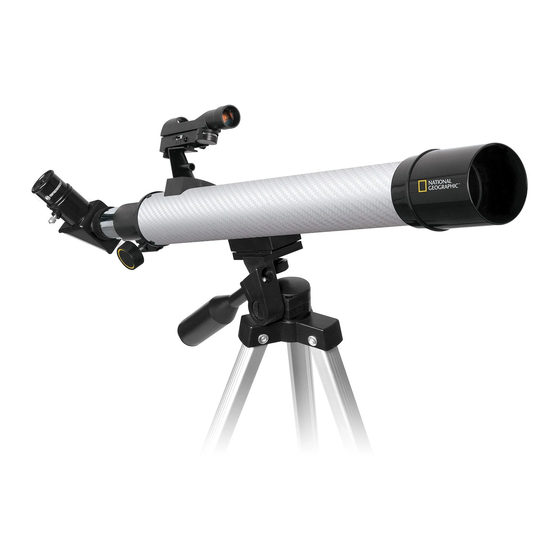Table of Contents
Advertisement
Adventure Set
50 mm Telescope w/ AZ Pan Tilt Mount,
900x Microscope Set, 4x30 Binoculars
Optical design
Magnification (with 2x Barlow lens)
Front lens (clear aperture)
Standard eyepieces
Finish
Accepts eyepiece barrel
Mounting
Eyepiece
Lenses
Magnification
Accessories
2
X
Do not mix old and new batteries. Do not mix alkaline,
NOT INCLUDED
1.5V
standard (carbon-zinc), or rechargeable (ni-cad, ni-mh, etc.) batteries.
WARNING:
SUN HAZARD — Never look directly at the sun
with this device.
Instruction Manual
Telescope Specifications
Microscope Specifications
Empty Vials, Spatula, Scalpel, Prepared
Slides, Blank Slides, Tweezers, Needle,
WARNING:
CHOKING HAZARD — Small parts.
Not for children under 3 years.
Visit us at: nationalgeographic.com
Achromatic refractor
30 - 48x (60 - 96x)
0.965" (12.5 mm and 20 mm)
24.51 mm (0.965")
AZ Pan Handle Mount
20x
5x, 20x, 45x
100x, 400x, 900x
Stirring Rod, Pipette
WARNING:
FUNCTIONAL SHARP POINT — Not for children
under 3 years.
1
80-30103
50 mm
600 mm/f12
Carbon fiber
Binocular Specifications
Lenses
30 mm
Magnification
1
X
CR2032
3V
INCLUDED
WARNING:
Contains button or coin cell battery.
Hazardous if swallowed — see instructions.
AGES
10 +
4x
Advertisement
Table of Contents

Subscribe to Our Youtube Channel
Summary of Contents for National Geographic Adventure Set
- Page 1 AGES 10 + Visit us at: nationalgeographic.com 80-30103 Adventure Set 50 mm Telescope w/ AZ Pan Tilt Mount, 900x Microscope Set, 4x30 Binoculars Instruction Manual Telescope Specifications Optical design Achromatic refractor Magnification (with 2x Barlow lens) 30 - 48x (60 - 96x)
- Page 2 National Geographic’s net proceeds support vital exploration, conservation, research, and education programs. SUN WARNING WARNING: NEVER ATTEMPT TO OBSERVE THE SUN WITH THIS DEVICE! OBSERVING THE SUN – EVEN FOR A MOMENT – WILL CAUSE INSTANT AND IRREVERSIBLE DAMAGE TO YOUR EYE OR EVEN BLINDNESS. Eye damage is often painless, so there is no warning to the observer that the damage has occurred until it is too late.
- Page 3 Visit us at: nationalgeographic.com How To Set Up Note: We recommend assembling your telescope for the first time in the daylight or in a lit room so that you can familiarize yourself with assembly steps and all components. 7ba)
- Page 4 National Geographic’s net proceeds support vital exploration, conservation, research, and education programs. Parts Overview 1. 50mm Objective Lens 2. Pan-Tilt Alt-Azimuth Mount 3. Tripod 4. Optical Tube Assembly (OTA) with Dew Shield 5. Focus Wheel 6. Diagonal 7. 0.965” Eyepieces (12.5mm and 20mm) 8.
- Page 5 Visit us at: nationalgeographic.com Using/Aligning the Red Dot Viewfinder: The viewfinder is powered by a CR-2032 battery that is included. Before using the viewfinder for the first time, remember to remove the plastic insulator that is blocking the battery from connecting. When it is time to replace the battery, remove the battery cap by loosening the set screw.
- Page 6 National Geographic’s net proceeds support vital exploration, conservation, research, and education programs. Using your telescope: After you have aligned your viewfinder, you are ready to start observing! Put the 20mm eyepiece into the diagonal to get the widest field of view. This wider field of view will make it easier to locate and track objects.
- Page 7 Visit us at: nationalgeographic.com SAFETY WARNINGS Read and follow the instructions, safety rules, and first aid information. • This microscope set is • Choking hazard: Children Do not immerse the battery should only use device compartment in water. intended for children under adult supervision.
- Page 8 National Geographic’s net proceeds support vital exploration, conservation, research, and education programs. Parts Overview 1. Eyepiece 10. (3) Prepared Slides and (3) Blank Slides 11. (3) Slide Covers & Labels 2. Focus Knob 12. (3) Collection Vials 3. Stage 13. Spatula 4.
- Page 9 Visit us at: nationalgeographic.com How Do I Use My Microscope Before you use your microscope, make sure that the table, desk or surface that you place it on is stable and is not subject to vibration. If the microscope needs to be moved, hold it by the arm and base while carefully transferring it. Once the microscope is in a suitable location and the batteries are installed, check the light source to make sure that it illuminates.
- Page 10 National Geographic’s net proceeds support vital exploration, conservation, research, and education programs. SUN WARNING WARNING: NEVER ATTEMPT TO OBSERVE THE SUN WITH THIS DEVICE! OBSERVING THE SUN – EVEN FOR A MOMENT – WILL CAUSE INSTANT AND IRREVERSIBLE DAMAGE TO YOUR EYE OR EVEN BLINDNESS. Eye damage is often painless, so there is no warning to the observer that the damage has occurred until it is too late.
- Page 11 7. Carry Bag Discover The World Around! Your National Geographic™ 4x30 binoculars are the perfect companion for countless outdoor adventures. With these sturdy binoculars, you can investigate amazing species and sights. Take them on a nature walk to get a detailed look at birds and other wildlife without disturbing them.
- Page 12 National Geographic’s net proceeds support vital exploration, conservation, research, and education programs. Determining Eye Distance The distance between one’s eyes varies from person to person, so it is essential that you adjust your binoculars before you use them. Take the binoculars in both hands (Fig. 1) and hold them to your eyes. Fold them so that you see a single circle when looking through them (Fig.
- Page 13 Visit us at: nationalgeographic.com Notes...
- Page 14 National Geographic’s net proceeds support vital exploration, conservation, research, and education programs. Notes...
- Page 15 Visit us at: nationalgeographic.com Notes...
- Page 16 National Geographic’s net proceeds Visit us at: nationalgeographic.com support vital exploration, conservation, research, and education programs. © 2017 National Geographic Partners LLC. All rights reserved. NATIONAL GEOGRAPHIC and Yellow Border Design are trademarks of the National Geographic Society, used under license.
















Need help?
Do you have a question about the Adventure Set and is the answer not in the manual?
Questions and answers